John P Laborde
-
- A TIME OF GREAT EXPECTATIONS, ENTHUSIASM AND EXCITEMENT Maritime Reporter, Jun 1981 #15
Taking a long hard look at the f u t u r e without resorting to crystal ball gazing of any kind, it's fair to say the offshore oil and gas support service industry in general and Tidewater Inc. in particular stand at the threshold of a m a g n i f i c a n t business environment. It is my firm belief that the long term will reflect substantial growth, progress and profitability, not only for our marine fleet, which is the world's largest by a substantial margin, but also for our c o m p r e s s i on service and oil and gas businesses.
Let's take a look at the current a r e n a f o r our marine business and see if the facts lead to the conclusion suggested.
In recent months, we have witnessed a firming utilization for our fleet of approximately 400 vessels and are now experiencing the strongest sustained demand in the 25 years since we first began operations in the Gulf of Mexico early in 1956. The demand is consistent in most, but not all, areas of the globe where our fleet is currently deployed.
As followers of the industry know, capital spending for exploration and development worldwide has resulted in a 99-percent utilization rate for mobile drilling rigs worldwide. More rigs are being built today than in any other industry period. New production facilities are also on the rise, up 84 percent over 1979. We are also optimistic that there will be more lease sales at more frequent intervals, and are hopeful t h a t further favorable action by the new Administration will continue a strong domestic offshore program that will keep apace with the current foreign demand. This level of exploration, development and production activity should result in maximum utilization of our fleet and usher in a period of great expectations and enthusiasm for the long term.
The Tidewater fleet is active in 28 areas of the globe with on-theground management that supports day-to-day operations for our charterers, who are primarily national oil companies and their contractors, international major oil companies, and drilling contractors.
We have responded to the surge in capital spending in exploration and development worldwide by acquiring existing equipment and by building new vessels. The number of vessels in our fleet has remained relatively c o n s t a n t f or several years but we maintain an active, ongoing program of upgrading, modernization and replacement.
During the last fiscal year ending March 31, 1981, we acquired or committed to construction 40 vessels which aggregated a total capital commitment of approximately $83 million. This is the largest annual capital commitment for marine equipment in Tidewater's history. If our current plans are realized, the capital commitment for fiscal year 1982 will exceed 1981 commitments.
In general, we have found that current shipyard costs are too high and charter rate structures in some operating areas have been too low to allow us to build all types of new equipment and expect it to currently yield appropriate returns. However, we are beginning to see rates improve to a level which will provide adequate returns and consequently we continue to examine new construction possibilities.
Tidewater has long enjoyed a position of leadership within the marine services industry. A greater number of vessels and a wider variety of specialized vessel types deployed to more locations around the globe than any single competitor have been important factors contributing to the company's leadership position. Another key factor has been the company's strong f i n a n c i a l position, which has provided muscle to withstand industry-wide difficult times, to respond to special vessel needs of our customers, and has permitted us the flexibility to make a wider range of business decisions quickly.
The 40 vessels that were acquired or committed to construction prior to the close of the past fiscal year are becoming available precisely when they will be needed most by the offshore oil and gas industry. And it goes without saying they will also be c o m p e t i t i v e in most operating areas of the world.
The present approximate value of our fleet, based upon acquisition cost as of March 31, 1981, including wholly owned and joint venture equipment, is $364 million.
Included in the fleet makeup are towing/supply and supply vessels, offshore tugs, crewboats, utility vessels, inland tugs, barges, crane vessels and other specialized equipment.
Nearly half of the number of vessels in the fleet (77 percent of aggregate fleet value) consists of towing/supply and supply vessels in the medium horsepower range, with the supply vessels forming the focal point of the company's current expansion program. The new vessels are equipped with an improved pumping system that provides liquid mud and other chemicels, in addition to fuel and water, to offshore drilling rigs.
Vessels in the class are fitted with twin Caterpillar D-399 engines which deliver 2,250 continuous horsepower, a speed of 12 knots, and are particularly suited for jackup drilling operations and other relatively shallow water exploration and development programs.
Equipped with the latest communication and n a v i g a t i on devices, they have air conditioned and heated quarters. The deck area is 114 feet by 34 feet, with below-deck storage that accommodates 4,000 cubic feet of bulk storage.
Along with the strong demand for new and acquired equipment, construction p r i c e s have shot up. Typically, a basic 180-foot straight supply boat with no towing gear and an open deck, could now cost at least $3.75 million.
A larger towing/supply vessel with winch, roller, and more power in the engine room could cost an additional million dollars or more. And as the industry moves f a r t h e r o f f s h o r e , larger, more powerful and higher-cost vessels will be required to support it.
There also has been a trend to "extra" or "special" equipment on our vessels. All or most transport drilling- f l u i d in internal tanks. There also are fire monitors.
Public and industry concern about blowouts, fire, collisions and other accidents at sea has also created the need for improved rescue and pollution control equipment. This new equipment is rapidly becoming standard in the industry.
Tidewater has responded in yet another direction with respect to its expansion program by "packaging" a broad range of specialized equipment built to the customer's specifications.
A recent example of such specialization is a 170-foot, 3,000- bhp support vessel for the rug- ged Bass Strait offshore Australia.
This vessel is designed to provide support for a remotecontrolled undersea submersible used to survey and monitor pipelines and underwater construction, and to aid seabed survey work. Important secondary functions of the vessel include diving and fireflghting roles. It is among the most advanced vessels currently engaged in the offshore oil and gas industry, and ranks high among the world's most specialized offshore support equipment.
The remote-controlled vehicle is attached to the vessel by cable, propels itself along the seabed or pipeline, and relays pictures by television camera to the mother vessel. The mother vessel keeps station on the remote-controlled vehicle by operating in the dynamic positioning mode.
Another specialized vessel with extreme shallow draft capability (six feet) is now under construction for geophysical applications in the Gulf of Mexico. This vessel will represent another "first" for the industry.
Tidewater is beefing up its fleet of inshore towing/supply vessels in the 72-foot class. These new vessels have an open foredeck area t h a t provides carrying capacity for 25 long tons of cargo. They are also equipped to deliver diesel fuel and fresh water to inland drilling rigs and platforms. The most innovative feature of the new tugs is that they permit the delivery of limited amounts of deck and liquid cargoes to the drilling rig that heretofore required the use of a barge working in combination with the vessel.
These vessels are certified by the U.S. Coast Guard to serve the oil and gas industry.
Tidewater continues to acquire offshore tugs in the 4,200 horsepower and larger classes to meet the requirements for towing new jack-up drilling rigs due to come into Gulf of Mexico service within the next few years.
Although there are no current plans to add to the 218-foot, 10,000-horsepower towing-supply vessels in our fleet, we continue to remain alert to the opportunity.
These vessels were in demand in the North Sea in the decade of the 70s, and their resurgence awaits the step-up in construction of semisubmersible drilling rigs and consequent exploration and d e v e l o p m e n t of areas far offshore, in deep water or in harsh operating environments.
The f u t u r e also appears geared for work in frontier areas in addition to established oil-producing areas around the globe. The West Coast of Alaska, the Beaufort Sea, the East Coast of Canada, Argentina, China, and other areas yet to be opened to exploration, suggest continued strong utilization for higher-horsepower vessels in the Tidewater fleet.
The increase in opportunity also poses some problems. Our domestic industry continues to be beset by an increase in the number of passive investors who have risen to the bait of the investment tax credit and accelerated depreciation for the immediate benefit of the investor's personal tax situation.
This has resulted in lower levels of profitability in the U.S.
Gulf for publicly held vessel operators such as Tidewater.
However, recent changes have been proposed both in the qualification standards for Maritime Administration Title XI financing, and in the level of investment tax credit availability as part of President Reagan's "Economic Recovery Tax Act of 1981." If consummated, these changes will substantially erode the benefits that these limited partnerships now enjoy and should result in their decline.
Future opportunities for the Tidewater fleet are impressive on a broad scale. We close in on this new decade in industry progress confident of demonstrating good operating results, and also with high expectations, e n t h u s i a sm and excitement, not only for our marine business segment but for our other lines of business, too.
-
- Wardwell Named Chairman And Lesch Elected Vice Chairman Of NOIA Maritime Reporter, May 1981 #22
of Houston, was elected vice chairman of the board. He has been chairman of the Association's Audit Subcommittee for four years. Mr. Wardwell succeeds John P. Laborde, chairman and CEO of Tidewater, Inc. New Orleans, who remains on the board as NOIA's immediate past chairman
-
- Tidewater To Supply 41 Tugs, Barges Under Two Multiyear Contracts Maritime Reporter, Feb 1991 #73
rig. All five rigs are contracted to Shell Oil of Nigeria under long-term arrangements. According to Tidewater chairman, president and chief executive John P. Laborde, the two contracts involve a total of 15 tugs and 26 barges. "The equipment will come from a group of recently acquired tugs and barges
-
- Tidewater Marine Acquires 5 Vessels From Otto Candies Maritime Reporter, Sep 1985 #5
, Inc., has completed an agreement to purchase a package of five vessels from Otto Candies, Inc. of Des Allemands, La. According to an announcement by John P. Laborde, Tidewater chairman and chief executive officer, on 135-foot, 5,600-bhp tug; three 105-foot, 3,600-bhp tugs; and one 300-foot offshore
-
- Currence Named President Of Tidewater Marine Maritime Reporter, Mar 1985 #10
D. DeLeo—to vice presidents of the parent company. Mr. Currence was also elected a senior vice president of Tidewater Inc. The announcement was made by John P. Laborde, chairman and chief executive officer of Tidewater Inc. Mr. Currence formerly served as president of Zapata Gulf Marine Corporation
-
- Tidewater Adds 11 Boats To Domestic Fleet Maritime Reporter, Aug 1990 #10
, such as these, Tidewater is fulfilling its goal of adding to and operating one of the largest, most versatile fleets in the industry today," said John P. Laborde, Tidewater chairman, president, and chief executive officer. Three large crewboats, Searich, Western Star, and Wendy Star, were purchased
-
- Three Executive Promotions Made By Tidewater Marine— Allgood Named President Maritime Reporter, Mar 15, 1981 #31
addition to the specialized domestic contracting services and demolition operations. Announcement of the election of the three new officers was made by John P. Laborde, Tidewater Inc. chairman, president, and chief executive officer, who said that additional organization changes in the sales, engineering
-
- Dr. P.W. Murrill Elected To Tidewater Board Maritime Reporter, May 15, 1981 #7
, Ethyl Corp. of Baton Rouge, and former chancellor of Louisiana State University, to the company's board of directors. This was announced by John P. Laborde, Tidewater chairman, president and chief executive officer, who said: "Dr. Murrill's superior academic and business background and experience
-
- Tidewater Elects Bankston President, Koock, Ramey Are New VPs Maritime Reporter, Oct 15, 1981 #8
and William J. Ramey as vice presidents. Mr. Bankston, former senior executive vice president and chief operating officer of Tidewater Inc., succeeds John P. Laborde who will remain as chairman and chief executive officer, a position he has held for the past 25 years. A native of Dawson, Texas, and
-
- Tidewater Christens M / V Reeves Tide— Halter-Built Oil Field Service Vessel Maritime Reporter, Mar 15, 1977 #7
the new 194-foot towing-supply vessel was Miss Margery M. Wetzel, a native New Orleanian who for the last 14 years has been the executive secretary to John P. Laborde, chairman and president of Tidewater. Gifts were presented to Miss Wetzel by Mr. Laborde, representing the owners, and by Harold P.
-
- Laborde And Wardwell Elected To Lead NOIA Maritime Reporter, Apr 15, 1980 #42
John P. Laborde of Tidewater, Inc. is the new chairman of the National Ocean Industries Association. He was elected by the b o a r d of d i r e c t o r s during the NOIA Eighth Annual Meeting, March 1980. Mr. Laborde, whose office is in New Orleans, La., has been active in the Association since its
-
- US Tank Barge Regs Loom, Laborde Presses Mitsubishi’s 'Mechanical Advantage' Maritime Reporter, Mar 2015 #52
the world’s largest offshore drilling company. With offshore rigs came the need for specialized support vessels, so Doc teamed with his younger brother, John P. Laborde (Tracy’s father), and founded Tidewater Marine Services, building the world’s first offshore supply boat designed specifically for the support
-
 )
March 2024 - Marine Technology Reporter page: 4
)
March 2024 - Marine Technology Reporter page: 4; Fax: (212) 254-6271 tional in London, perennially one Lof the world’s most important Justin Zuure CEO events serving the global subsea market. John C. O’Malley [email protected] Personally, it was my ? rst return to London for this event since 2018, as the 2020 ‘50th Anniversary’ edition
-
 )
April 2024 - Maritime Reporter and Engineering News page: 28
)
April 2024 - Maritime Reporter and Engineering News page: 28to provide all of the end-to-end logistics the force will require in a future major con? ict. U.S. Navy photo by Mass Communication Specialist 2nd Class John Bellino 28 Maritime Reporter & Engineering News • April 2024 MR #4 (18-33).indd 28 4/5/2024 8:27:05 A
-
 )
April 2024 - Maritime Reporter and Engineering News page: 27
)
April 2024 - Maritime Reporter and Engineering News page: 27Sailors. We have 14 Henry J. Kaiser-class ? eet replen- high-speed craft (HSC) training. So, MyMSC will help track ishment oilers and three of the new John Lewis class of ? eet and manage all of those different things in one place. We’re replenishment oilers, with more on the way. We have 14 Lew- hoping
-
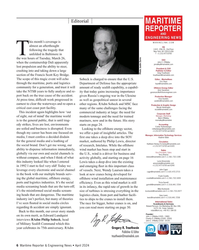 )
April 2024 - Maritime Reporter and Engineering News page: 6
)
April 2024 - Maritime Reporter and Engineering News page: 6St., 2nd Floor following the tragedy that New York, NY 10010 USA T +1.212.477.6700 Tunfolded in Baltimore in the wee hours of Tuesday, March 26, CEO John C. O’Malley when the containership Dali apparently [email protected] lost propulsion and the ability to steer, President & COO Publisher & Editor cra
-
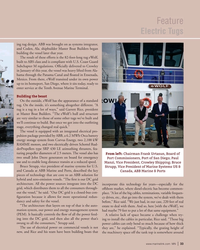 )
April 2024 - Marine News page: 33
)
April 2024 - Marine News page: 33SRP 430 LE azimuthing thrusters, fea- turing propeller diameters of 2.5 meters. The vessel also has From left: Chairman Frank Urtasun, Board of two small John Deere generators on board for emergency Port Commissioners, Port of San Diego; Paul use and to enable long distance transits at a reduced speed. Manzi
-
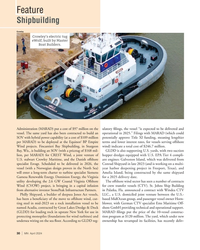 )
April 2024 - Marine News page: 30
)
April 2024 - Marine News page: 30The offshore wind sector has seen a number of contracts Wind (CVOW) project, is bringing in a capital infusion for crew transfer vessels (CTV). St. Johns Ship Building from alternative investor StonePeak Infrastructure Partners. in Palatka, Fla. announced a contract with Windea CTV Philly Shipyard
-
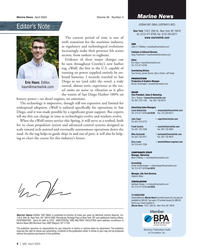 )
April 2024 - Marine News page: 4
)
April 2024 - Marine News page: 4.marinelink.com The current period of time is one of swift transition for the maritime industry, CEO as regulatory and technological evolutions John C. O’Malley • [email protected] increasingly make their presence felt across Publisher & Editorial Director Greg Trauthwein • trauthwein@marinelink
-
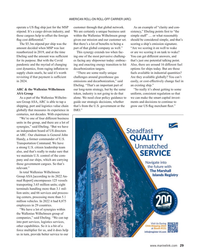 )
February 2024 - Maritime Reporter and Engineering News page: 29
)
February 2024 - Maritime Reporter and Engineering News page: 29units in the group, and there are a lot of synergies,” said Ebeling. “But we have an independent board of US directors at ARC. Our chairman is General John Handy, a former commander of U.S. Transportation Command. We have a strong U.S. citizen leadership team also, and that’s really to make sure that
-
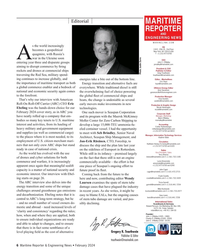 )
February 2024 - Maritime Reporter and Engineering News page: 6
)
February 2024 - Maritime Reporter and Engineering News page: 6HQ 118 E. 25th St., 2nd Floor becomes a geopolitical New York, NY 10010 USA T +1.212.477.6700 quagmire, with Russia’s Awar in the Ukraine soon CEO John C. O’Malley entering year three and disparate groups [email protected] aiming to disrupt commerce by ? ring President & COO Publisher & Editor rocke
-
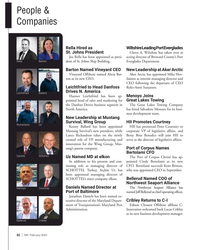 )
February 2024 - Marine News page: 42
)
February 2024 - Marine News page: 42People & Companies Rella Hired as Wiltshire Leading Port Everglades St. Johns President Glenn A. Wiltshire has taken over as Joe Rella has been appointed as presi- acting director of Broward County’s Port Rella Barton dent of St. Johns Ship Building. Everglades Department. Barton Named Vineyard CEO New
-
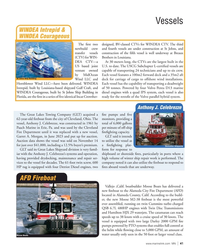 )
February 2024 - Marine News page: 41
)
February 2024 - Marine News page: 41& WINDEA Courageous The ? rst two designed, BV-classed CTVs for WINDEA CTV. The third newbuild crew and fourth vessels are under construction at St Johns, and transfer vessels construction of the ? fth vessel is well underway at Breaux (CTV) for WIN- Brothers in Louisiana. DEA CTV—a At 30 meters long
-
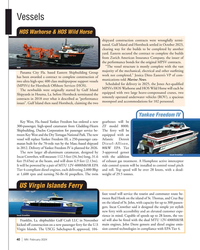 )
February 2024 - Marine News page: 40
)
February 2024 - Marine News page: 40Islands Ferry foot vessel will service the tourist and commuter route be- tween Red Hook on the island of St. Thomas, and Cruz Bay on the island of St. John, with capacity for up to 300 passen- gers. Incat Crowther said it designed the simple yet stylish new ferry with accessibility and an elevated customer
-
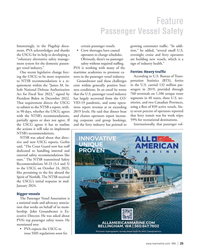 )
February 2024 - Marine News page: 25
)
February 2024 - Marine News page: 25mid- January 2024. Bigger vessels The Passenger Vessel Association is a national trade and advocacy associa- tion that works on behalf of its mem- bership. John Groundwater is Ex- ecutive Director. He was asked about PVA’s top passenger safety issues. He mentioned two: • PVA expects the USCG to issue SMS
-
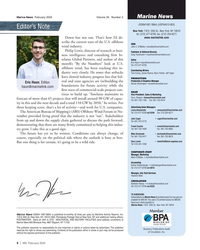 )
February 2024 - Marine News page: 4
)
February 2024 - Marine News page: 4477-6700; fax: (212) 254-6271 www.marinelink.com Down but not out. That’s how I’d de- scribe the current state of the U.S. offshore CEO wind industry. John C. O’Malley • [email protected] Philip Lewis, director of research at busi- Publisher & Editorial Director Greg Trauthwein • trauthwein@marinelink
-
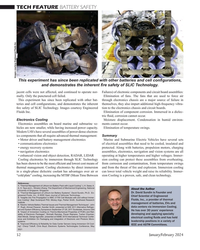 )
January 2024 - Marine Technology Reporter page: 52
)
January 2024 - Marine Technology Reporter page: 52Smith, Southwest Research Institute management of batteries, EVs and 4. “Electric Vehicle Battery Thermal Issues and Thermal Management Techniques”, John data centers via Immersion Cooling. P. Rugh, Ahmad Pesaran, Kandler Smith; presented at SAE 2011 Alternative Refriger- ant and System Ef? ciency
-
 )
January 2024 - Marine Technology Reporter page: 4
)
January 2024 - Marine Technology Reporter page: 4(though not for attribution or reporting) Justin Zuure on the path, direction and importance of the CEO subsea vehicle market. Sitting at that table John C. O’Malley [email protected] that night were several U.S. Navy Admirals as well as the CEOs from about a dozen autonomous underwater vehicle
-
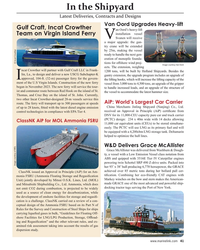 )
January 2024 - Maritime Reporter and Engineering News page: 41
)
January 2024 - Maritime Reporter and Engineering News page: 41ist and commuter route between Red Hook on the island of St. the vessel to accommodate the latest hammer size. Thomas, and Cruz Bay on the island of St. John. Currently, two other Incat Crowther-designed 28-m vessels service this AiP: World’s Largest Car Carrier route. The ferry will transport up to 300
-
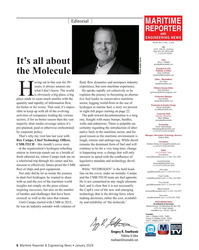 )
January 2024 - Maritime Reporter and Engineering News page: 6
)
January 2024 - Maritime Reporter and Engineering News page: 6Editorial MARITIME REPORTER AND ENGINEERING NEWS M A R I N E L I N K . C O M HQ 118 E. 25th St., 2nd Floor New York, NY 10010 USA T +1.212.477.6700 CEO John C. O’Malley It’s all about [email protected] President & COO Publisher & Editor Greg Trauthwein the Molecule Photo Justin Zurre trauthwein@marinelink
-
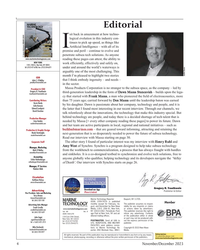 )
November 2023 - Marine Technology Reporter page: 4
)
November 2023 - Marine Technology Reporter page: 4is arguably one of the most challenging. This Justin Zuure month I’m pleased to highlight two stories CEO that I think embody ingenuity – and needs – John C. O’Malley [email protected] in the sector. Massa Products Corporation is no stranger to the subsea space, as the company – led by President
-
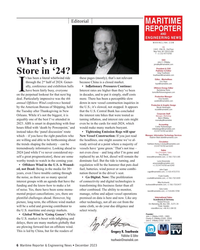 )
December 2023 - Maritime Reporter and Engineering News page: 6
)
December 2023 - Maritime Reporter and Engineering News page: 6Editorial MARITIME REPORTER AND ENGINEERING NEWS M A R I N E L I N K . C O M HQ 118 E. 25th St., 2nd Floor New York, NY 10010 USA T +1 212 477 6700 CEO John C. O’Malley What’s in [email protected] President & COO Publisher & Editor Greg Trauthwein Store in ‘24? [email protected] t has been
-
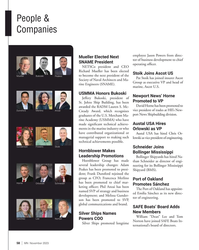 )
November 2023 - Marine News page: 58
)
November 2023 - Marine News page: 58VP and head of rine Engineers (SNAME). marine, Ascot U.S. USMMA Honors Bukoski Newport News’ Horne Jeffery Bukoski, president of Promoted to VP St. Johns Ship Building, has been David Horne has been promoted to awarded the RADM Lauren S. Mc- Merlino Dunsford Anzai Cready Award, which recognizes
-
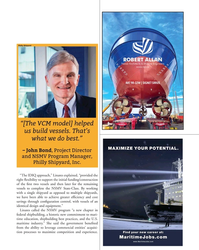 )
November 2023 - Marine News page: 41
)
November 2023 - Marine News page: 41Philly Shipyard “[The VCM model] helped us build vessels. That’s what we do best.” – John Bond, Project Director and NSMV Program Manager, Philly Shipyard, Inc. “The IDIQ approach,” Linares explained, “provided the right ? exibility to support the initial funding/construction of the ? rst two
-
 )
November 2023 - Marine News page: 39
)
November 2023 - Marine News page: 39up to ? ve NSMVs. Keel laying for the Empire State was in May 2021. Ben Christian is TOTE Services’ VP for Business Devel- opment and New Construction. John Bond is Project Di- rector and NSMV Program Manager for Philly Shipyard, Inc. The two were asked for their insights and advisories about the VCM process
-
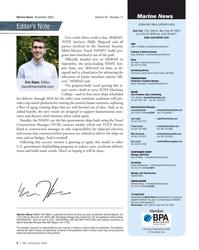 )
November 2023 - Marine News page: 4
)
November 2023 - Marine News page: 4254-6271 www.marinelink.com Give credit where credit is due. MARAD, TOTE Services, Philly Shipyard and all CEO parties involved in the National Security John C. O’Malley • [email protected] Multi-Mission Vessel (NSMV) build pro- Publisher & Editorial Director Greg Trauthwein • trauthwein@marinelink
